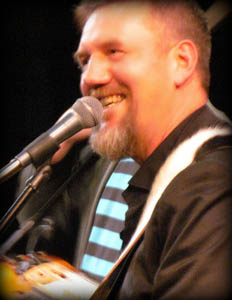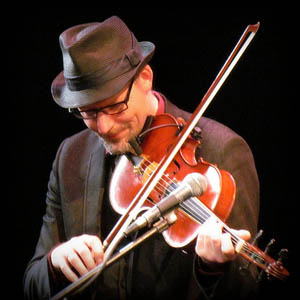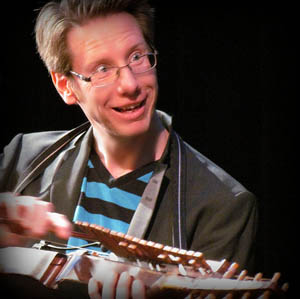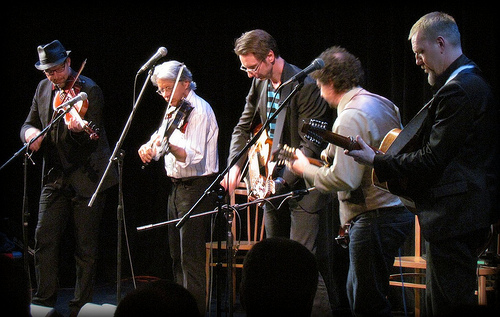

|
Väsen


|
|
"This is not the band for big crowds; this is the band for people with good taste."
"This is not the band for big crowds; this is the band for people with good taste." That's one way nyckelharpa player Olov Johansson describes Väsen, the band he started 22 years ago with violist Mikael Marin and guitarist Roger Tallroth. I had the opportunity to talk with the members of Väsen both before and after their live performance in Boise, Idaho, in March 2011, where they shared the evening with 'The Duo,' mandolinist Mike Marshall and fiddler Darol Anger. My assumption was that the Boise audience would not be all that familiar with the music of the Swedish trio. I asked if there was anything they wished audience members knew before coming to the show. Tallroth jumped in first, with enthusiasm. "We are pioneers; prepare to be taken on a journey," he said with a broad, theatrical grin. Johannson responded more quietly, focusing his attention on each sentence. "I want the audience to have an open mind. If people will listen to three of our tunes, we'll catch them." "And audiences in the US," continued Tallroth, "are open-minded and direct. They are not so shy. In the US everything falls into place." Watching this exchange, Marin smiled, nodded, sipped his espresso.
 Roger Tallroth The way these three men talked with me mirrored much of their interaction on stage. The way they listened to each other, responded, reacted, how they set up the next comment or expression was a reflection of how they worked together as they played through "Rob's Polska" or "One Hour in Hungary" later that evening. Making another assumption, I suggested to the band that the audience in Boise probably was not familiar with traditional Swedish music. Tallroth jumped in: "We make our own standards. This is not traditional fiddle music. It's too new, too complex, too quirky." Johannson followed up. "The audience reaction depends on the musical references the audience has. Some people think Väsen is traditional, but while we have ties to tradition every year our music sounds more and more like Väsen music." When asked how long it took to find their musical voice, Marin said, "I don't know that I'll ever settle in on one voice. Musical growth is always important, and I'm always refining my voice through playing and composing. That's what makes what we do a living tradition."
 Mikael Marin Väsen certainly understands traditional music. Both Johannson and Marin studied with traditional musicians from Sweden's Uppland region, and they knew a lot of the same tunes when they first met in the 1980s. They met Tallroth at a music camp in Norway and began playing together. When Johannson became the first world champion nyckelharpa player in 1990, he invited Marin and Tallroth to record a CD with him and Väsen was born. I first heard both Marin and Tallroth on recordings led by the Norwegian harbinger fiddle player, Annbjørg Lien. I could think of many instances of Swedes and Norwegians playing together and I asked if there was a special bond between Sweden and Norway that is different than the relationship with musicians from other nearby countries. They pointed out that while Väsen has collaborated with the Finnish band JPP, it's just easier for them to work with Norwegians for a number of reasons, including the very long border the countries share and the similarities in language. "Norwegian is like a dialect of Swedish," said Tallroth, "and the Norwegians have long had better educational opportunities for musicians to work together."
 Olov Johansson Johannson added, "We've been on a journey for over 22 years that has brought us to many places and allowed us to meet up with many musicians." Johannson mentioned their collaboration with the Irish band Dervish and their 2007 recording with Americans Mike Marshall and Darol Anger, the project that had brought them to Boise. Later in the evening over beers, Marshall asked who their next collaborator might be. "A Balkan brass band," beamed Marin, "because it sounds impossible to make it work." In these days of iPod shuffles, I'm always curious about how artists think about albums and their thoughts about being shuffled with other artists and genres. Johannson said they still think about the album, "But this may have more impact for the band than for the audience. For us it's an imprint of this time." Tallroth compared a finished CD to a painting, to something physical that shows the artistic vision of a specific point. "It also helps us sharpen our tools," added Marin. "The act of going into the studio adds a specific focus to what the band does."
 Väsen & 'The Duo' of Mike Marshall and Darol Anger CDs are also necessary for shows; there aren't any good ways to autograph MP3s. When people attend a show, they want to be able to purchase something that includes songs the band played that night. It represents more than just music. "This is our brand," Tallroth proclaimed. When I asked how much the arrangements of tunes change over time, Johannson related a description of Väsen he really liked. "We sound like three soloists playing at the same time but still listening to each other." The music has many layers, even though there are only three players. "We always try to be in the moment," said Johannson. Tallroth jumped in, saying "It's always hard to repeat success, and for us it's most important to be in the present." Noting that there is a continuous refinement happening on stage, Tallroth added, "We are always searching for solutions in real time." "And yet," said Marin, "it's kind of orchestral." I was quite surprised in concert that even though I could see all three musicians very clearly I often had a difficult time distinguishing who was making which sound. They blend together so well, and trade off expertly between melodies, harmonies, accompaniment, and counter melodies that it is the ensemble that takes center stage rather than any one player. "We each have our territories," said Johannson, "but we are free to do many things inside that territory." That sense of an ensemble with three soloists, of blending individual expression within boundaries, makes Väsen sound extraordinarily big. "We've always wanted to sound like more than three," said Tallroth. "We want to sound like six or seven." After the show, I told them how quickly they won over the audience and how much fun we had as audience members. They were all obviously very happy to be playing for us, and that happiness was infectious. Marin smiled the biggest grin I had seen all day, then quickly deadpanned, "We weren't really having fun. It's all an act, because we are professionals." His eyes twinkled as he took another sip of beer, with Johannson beside him chuckling and Tallroth on the other side bursting into his biggest laugh of the evening.
Text: Greg Harness For a bit of historical perspctive, read the RootsWorld interview with the band while on their first tour of America
|
|
© 2010 RootsWorld. No reproduction of any part of this page or its associated files is permitted without express written permission.
|